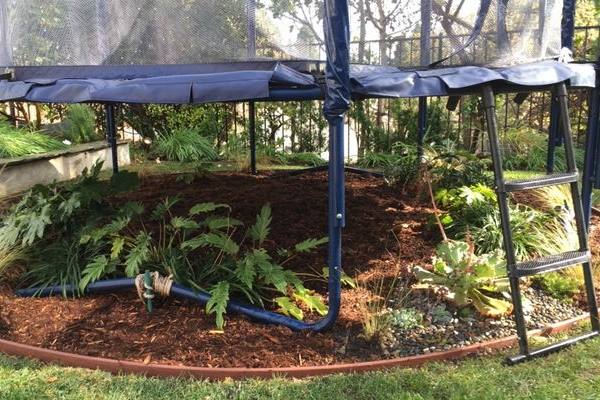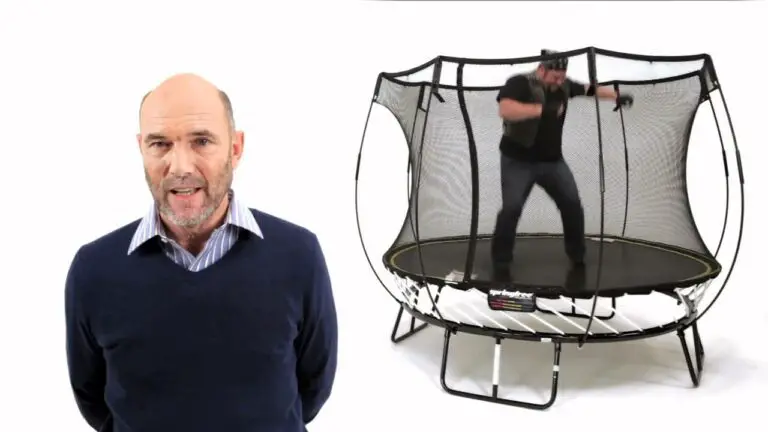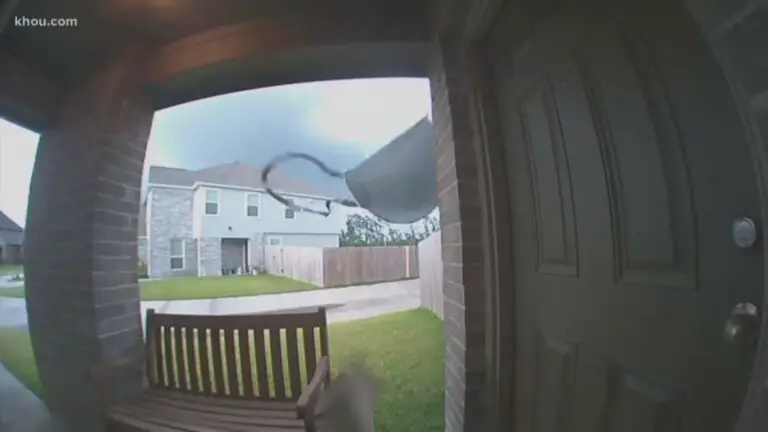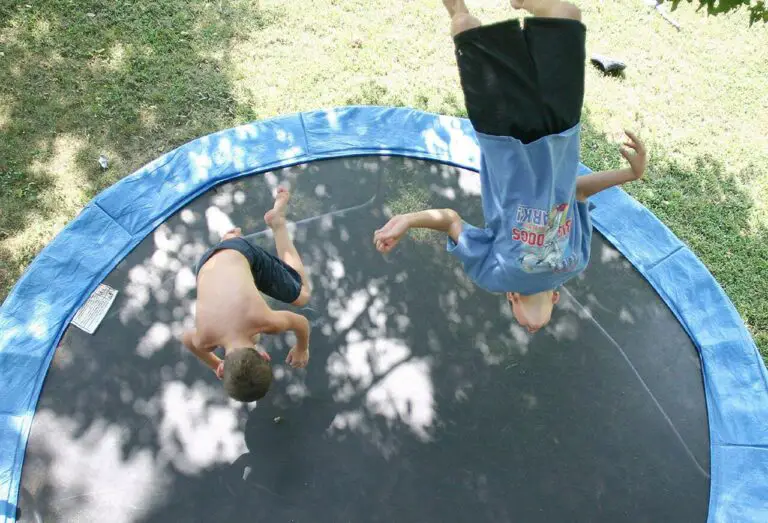Most people don’t know what to put under a trampoline. They just assume that any old thing will do. But that’s not the case!
There are actually a few things you should consider putting under your trampoline to prolong its life and keep it safe.
If you have a trampoline in your backyard, there are a few things you should consider before letting your kids loose on it. For starters, you’ll need to make sure the area around the trampoline is clear of any obstacles. You don’t want your kids running into something and getting hurt.
Another thing to consider is what you’re going to put under the trampoline. A lot of people opt for grass, but this can be a problem if it’s wet or muddy. If you live in an area with a lot of rain, you might want to consider putting something else under the trampoline like rubber mats or sand.
This will help keep the area around the trampoline clean and dry.
Don’t Know What To Do With Space Under a Backyard Trampoline?
Grass Mat for under Trampoline
A trampoline is a great addition to any backyard and provides hours of fun for kids and adults alike. However, if you don’t have the right surface beneath your trampoline, it can be dangerous. A grass mat for under your trampoline will provide asoft landing surface in case someone falls, and it will also protect your lawn from being damaged by the feet of the trampoline.
When choosing a grass mat for under your trampoline, make sure to get one that is specifically designed for this purpose. There are many different sizes and styles available, so you should be able to find one that fits your needs perfectly. Be sure to read the reviews before purchasing to ensure that you’re getting a quality product.
Installing a grass mat for under your trampoline is relatively easy. Simply place it underneath the frame of the trampoline and secure it with straps or zip ties. Once it’s in place, you can add some additional padding on top if desired.
This will help to create an even softer landing surface.
If you have a rectangular or square-shaped trampoline, then you’ll need to purchase two mats – one for each side. But if you have a roundtrampoline, only one mat is necessary.
No matter what type of trampoline you have, though, always make safety your top priority!
Rubber Mat for under Trampoline
Are you looking for a way to keep your trampoline anchored to the ground and prevent it from moving around? If so, then you need a rubber mat for under your trampoline. A rubber mat is a great way to keep your trampoline in place, as well as protect the flooring beneath it.
There are a few things to consider when choosing a rubber mat for under your trampoline. First, you need to make sure that the mat is large enough to fit under the entire trampoline. You also want to make sure that the mat is thick enough to provide adequate cushioning and support.
Additionally, you’ll want to choose a mat made from durable materials that can withstand weather and wear and tear.
Once you’ve selected the perfect rubber mat for under your trampoline, simply place it underneath the entire frame of the trampoline. This will help anchor the trampoline in place and prevent it from moving around.
Additionally, the cushioning provided by the rubber mat will help protect your flooring from damage caused by jumping on the trampoline.
Base for Trampoline
When you are ready to purchase a trampoline, you will need to decide on the size and shape that is right for you. You will also need to select a base for your trampoline. The base is an important part of the trampoline as it provides stability and keeps the frame in place.
There are several different types of bases available for trampolines.
The most common type of base is the ground-based model. This type of base is placed directly on the ground and secured with stakes or sandbags.
Ground-based bases are typically used for smaller trampolines or those that will be placed in an area where there is not a lot of space.
Another type of base is the above-ground model. This type of base is attached to a structure such as a deck or patio.
Above-ground bases are ideal for larger trampolines or those that will be used in an area where there is more space available.
In-ground models are another option for securing your trampoline. This type of base is installed into the ground and can be flush with the surface or slightly elevated.
What to Put under Trampoline on Concrete
If you have a trampoline that will be placed on concrete, there are a few things that you can do to make sure that it is safe and stable. First, you will want to purchase some mats that are designed specifically for trampolines. These mats will help to keep the trampoline in place and will also provide a bit of cushioning in case someone falls off of the trampoline.
You may also want to consider putting some sand under the trampoline as well. This will help to keep the trampoline from moving around too much and will also provide extra cushioning in case of a fall.
Clover under Trampoline
If you have a trampoline in your yard, you’ve probably seen a clover or two growing underneath it. While it may seem like an eyesore, there are actually several benefits to having clover growing under your trampoline.
For one, clover is a natural weed suppressor.
This means that it can help keep other unwanted plants from taking over the area beneath your trampoline. Clover also has deep roots which help to anchor the trampoline and keep it from blowing away in strong winds.
In addition, clover is known for its nitrogen-fixing properties.
This means that it can help fertilize the soil beneath your trampoline, making it more fertile and better able to support other plants. Clover is also relatively drought-resistant, so it’s a good choice for areas that don’t get a lot of rainfall.
So if you see some clover sprouting up under your trampoline, don’t be too quick to pull it out!
It may not be as pretty as some other plants, but it can actually be quite helpful in keeping your trampoline area healthy and productive.
Growing Vegetables under Trampoline
If you have a backyard and some extra space, you can grow your own vegetables. You don’t need a lot of space to do it, either. A trampoline is the perfect place to set up a small garden.
Just make sure that the trampoline is in a sunny spot.
You can grow all sorts of vegetables under a trampoline. lettuce, tomatoes, peppers, and more.
Just put some soil in buckets or bags, and arrange them around the edge of the trampoline. Water regularly and soon you’ll have fresh veggies to enjoy!
Trampoline Skirt Ideas
When it comes to trampoline skirt ideas, there are a lot of different ways that you can go about it. You can either make your own skirt or purchase one pre-made. If you decide to make your own skirt, there are a few things that you will need to keep in mind.
First, you will need to determine the size of the trampoline that you have. This is important because you want to make sure that the skirt fits properly and does not sag in any areas. Second, you will need to choose the fabric that you want to use for the skirt.
There are a lot of different options out there, so take some time to look around and find something that you like. Third, you will need to sew the fabric together using a sewing machine or by hand stitching it together. Fourth, once the fabric is sewn together, you will then need to attach it to the trampoline frame using velcro strips or zip ties.
And lastly, once everything is attached, test out the skirt on your trampoline before allowing anyone else to use it.
If purchasing a pre-made skirt is more your style, then there are still a few things that you will need to keep in mind. First, as with making your own skirts, you will need to know what size trampoline frame you have so that you can purchase the proper size skirt.
Second, when looking at pre-made skirts, pay close attention to how they are constructed and what type of fabrics are used. You want something that is well made and will not tear easily. Lastly, as with anything else related to safety on a trampoline, always test out the new piece of equipment before allowing anyone else on the trampoline with it – this goes for kids AND adults!
Now that we’ve gone over some general tips for both making and purchasing a trampoline skirt, let’s get into some specific ideas! For those who love DIY projects (and saving money), consider making your own tutu style skirt using tulle fabric in whatever color(s) desired – perfect for little girls who love playing dress up on theirtrampolines! Or if taking on a sewing project isn’t really your thing but buying premade seems too expensive OR limiting in terms of design/color options – no worries!
Where to Put Trampoline in Yard
There are a few things to consider when deciding where to put your trampoline in your yard. First, you’ll want to make sure the area is large enough for the trampoline and that there’s no furniture or other objects nearby that could damage it. You’ll also want to avoid placing the trampoline too close to trees or other structures, as this could present a safety hazard.
Once you’ve found a suitable location, mark off the area with chalk or tape so you can be sure not to move it later on. With these tips in mind, you should be able to find the perfect spot for your new trampoline!

Credit: www.gettrampoline.com
What is the Best Base for a Trampoline?
There are a few factors to consider when determining the best base for a trampoline. The first is the size of the trampoline. A larger trampoline will need a stronger and more sturdy base than a smaller one.
The second factor to consider is the weight limit of the trampoline. Heavier people will need a sturdier base than lighter people. The last factor to consider is the type of terrain you’ll be setting up your trampoline on.
If it’s uneven or soft, you’ll want to make sure your base is extra sturdy so it doesn’t tip over or sink into the ground.
Assuming all other factors are equal, we would recommend concrete as the best base for a trampoline. It’s strong and durable, so it can support even heavy users, and it won’t sink into soft ground like grass or sand.
If you don’t have access to concrete, asphalt is also a good option. It’s not quite as strong as concrete, but it’s still fairly durable and should be able to support most users without issue.
What Surface Can You Put a Trampoline On?
A trampoline can be placed on a variety of surfaces, including grass, concrete, and asphalt. The best surface for a trampoline is one that is level and firm. A soft surface like grass can cause the trampoline to sink or collapse.
A hard surface like concrete can be too slippery and dangerous. Asphalt is a good option because it is firm but not too slippery.
How Do I Prepare My Yard for a Trampoline?
If you’re lucky enough to have a trampoline in your backyard, you know the hours of fun and exercise it can provide for your family. But did you know that there’s more to owning a trampoline than just putting it together and jumping on? In order to keep your trampoline in tip-top shape (and keep everyone safe while using it), there are some things you should do to prepare your yard before setting up the trampoline.
First, take a look at the area where you want to place the trampoline. You’ll need a level spot that’s free of any debris or sharp objects. Once you’ve found the perfect location, clear away any rocks, sticks, or other objects that could puncture the mat or injure someone if they fell on them.
Next, check for underground hazards like power lines or water pipes. If there are any underground cables or pipes running through your proposedtrampoline site, move the trampoline elsewhere. It’s not worth risking serious injury (or damage to property) by placing the trampoline over these hazards.
Now that your yard is prepped and ready, it’s time to set up the trampoline! First, lay out all of the components on flat ground so you can see what goes where. Then follow the manufacturer’s instructions for assemblingthe frame and attachingthe mat.
Once everything is put together according to specifications, give each joint afinal tighten with a wrenchto make sure everything is extra secure.
Last but not least, don’t forget about safety netting! This is one of the most important parts of owninga trampoline, as it helps prevent injuries from falls off ofthe sides.
Most nets attach easilyto metal frames with zip ties or similar fasteners; just be sure to follow instructions carefully so you don’t accidentally damage anything while attachingit.
And that’s it!
Can You Put a Trampoline on Grass?
You can put a trampoline on grass, but there are a few things to keep in mind. First, you’ll need to choose a spot that is level and free of any rocks or other objects that could puncture the trampoline’s mat. Second, you’ll need to make sure the area around the trampoline is clear of any obstacles that could trip someone using the trampoline.
Finally, it’s always best to have someone supervising when people are using a trampoline, regardless of where it is located.
Conclusion
If you have a trampoline, you might be wondering what to put under it. Here are some things to consider:
-The ground should be level so the trampoline is stable.
-You’ll need something to cushion the fall, like grass or mulch.
-Make sure there’s no debris around that could cause injury if someone fell on it.
-It’s also a good idea to have a mat or tarp underneath in case of rain or snow.





